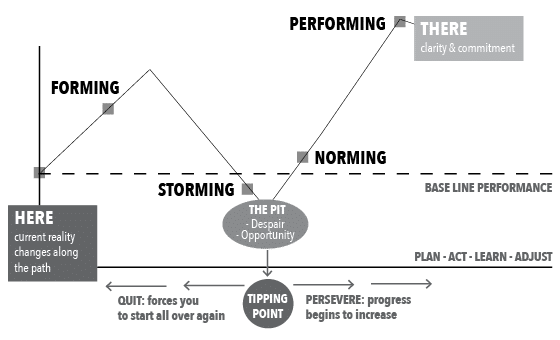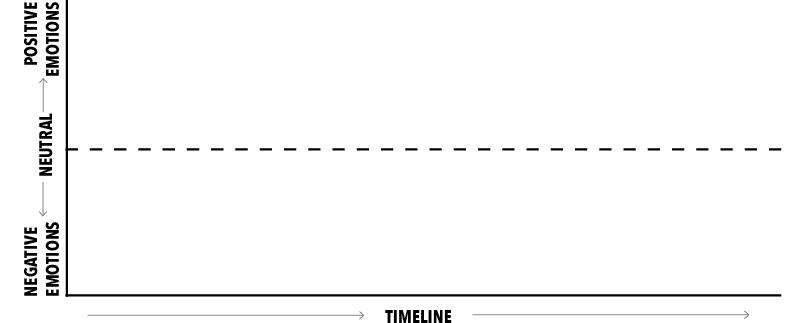Developing Perseverance and Perspective
Project Mood Curve:
Persevering through difficulty is a mandatory requirement for getting There.
The Project Mood Curve describes the PATH between HERE and THERE. Our journey between where we are and where we are going will inevitably follow this curve. The mood curve shows our opportunity, power, and reason for perseverance during our journey.

The Mood Curve is inescapable
Nothing is immune to the Mood Curve. Every human relationship, project, and organization travels along this PATH. The only difference between one PATH and another is the depth of the “pit of despair” that must be navigated. You don’t get to choose the circumstances or the depth of the pit, but you can choose to own the 3 things you can control within it. It is important to understand that the Project Mood Curve can be experienced both in individual undertakings, and in a team dynamic.
There are five phases to the mood curve:
1. Forming
We begin a project or a relationship with hopes and expectations for its success and its effect on us. Since we have so many options to choose from, we only get involved in a venture if we think we will benefit from it. Every new thing goes through this “honeymoon phase”––relationships, jobs, projects.
2. Storming
However, the honeymoon phase never lasts. Reality never lives up to our hopes and expectations. So, we enter the “storming” phase (also known as the pit of despair). Now that the honeymoon phase is over, unexpected conflict and challenges emerge.
Though we try to avoid this phase, we have to go through it. In fact, it proves useful for growing closer to those around us and achieving our vision. We grow much closer to those in our organization because of the intensity of the challenges that we face together in the pit.
The pit is not just to be endured, but valued––we are refined by fire. When we’re in the pit, we only have two choices: quit or persevere.
3. Quitting
At the decision point, we can either quit or keep going. When we quit, it’s for one of two reasons: we’ve decided that the pains of the challenges outweigh our THERE or we believe that encountering difficulties is in and of itself a failure.
Sometimes, quitting is the right choice. When we quit, we can choose a better objective. However, we have to keep in mind that if we quit, we start over at the forming phase.
If we choose to quit, we have another choice to make. Will we choose to view quitting as an opportunity to reset and start a better objective? Or will we view quitting as failure, deciding that we are worthless and should not try anything else.
4. Norming
If we persevere, we enter the norming stage. We have learned from the pit. Now, we are in the process of resolving conflict, building trust, and growing, individually and as a team.
5. Performing
In the performing stage, we succeed in ways that exceed the future we imagined in the forming stage. We have learned and adapted throughout the process of the mood curve, refining our vision and goals to meet reality and serve purpose.
Unfortunately, the performing stage doesn’t last forever. We recycle through the mood curve as challenges and new goals arrive, reaching higher and higher, as we continue to serve our THERE.
Mood Curve Misnomers
LIE: Everyone will be in the same zone at the same time in a team/relationship dynamic.
TRUTH: Our curves will all look different, even when we are walking down the same path together. Unity is not conformity – our individual values, beliefs and perspectives will highly influence our Mood Curve experience.
LIE: Quitting is never a good thing.
TRUTH: While we need to learn commitment and how to persevere through difficult things, quitting is not always a bad thing. We need to make sure we are on the right path, and that the THERE we are pursuing aligns with our values.
LIE: Choosing to stay in the pit will keep you from quitting.
TRUTH: Choosing to stay in the pit is the same as quitting. There is no place on the Mood Curve where you can set up camp, you will constantly be moving through the curve, and a refusal to do so is the equivalent of quitting. Your new project may be apathy or a “refusal” to do anything, but even that endeavor will follow The Mood Curve.
LIE: Performing is the final destination and the place worth living for.
TRUTH: Life is full of ups and downs. As we learn, grow, and succeed, our potential for output gets higher and our pit is less deep. But The Mood Curve continues and recycles, always in motion.
Mood curve examples
Where are you on the Mood Curve right now? How committed are you to the vision? How sure are you that it aligns with your values? Think about a recent project or undertaking you have been involved in. Using the image below, chart your own Mood Curve. What do you notice about it?



